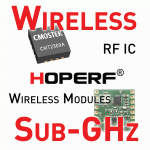
HopeRF – CMT2300A + CMT2x19B Sub-GHz Solution: For many applications where wireless data transmission is required, a sub-GHz band is still the first choice. Operation takes place in the licence-free ISM frequency range. The range is significantly greater than, for example, with 2.4 GHz radio solutions. In addition, a sub-GHz radio solution is less affected by interference and can be significantly more energy-efficient.
Smart metering, home automation, wireless sensors and many other IoT applications benefit from sub-GHz wireless technology.
The manufacturer HopeRF has been offering cost-efficient and power-saving solutions for sub-GHz radio applications since 2004. HopeRF not only offers transceiver ICs, but also pure transmitters and receivers. These are available as ICs, SoCs with controller core or as modules.
In the following, we present a family that includes a sub-GHz transceiver (CMT2300A), a transmitter (CMT2119B) and a receiver (CMT2219B) as separate ICs. The ICs are function-, pin- and layout-compatible, except for the unconnected RF inputs on the transmitter and the PA output on the receiver. Therefore, a single design can be realised in suitable applications, in which the transceiver or only one transmitter or receiver is equipped, depending on the application, which will save development effort and costs in the end.
The CMT2300A is a high performance OOK and (G)FSK transceiver with very low power consumption. The transmit and receive frequency can be set in a range of 127MHz..1020MHz. With transmit powers up to +20dBm and sensitivity up to -121dBm, the performance can be optimised for the given application.
The transceiver includes many other features that allow it to be set up in the best possible way for the particular application. The integrated sleep timer can periodically wake up the chip. Depending on the set duty cycle mode, this allows, as an example, the transmit function to run fully automatically and thus achieve a high level of energy efficiency.
The Phase Jump Detector (PJD) helps to distinguish desired signals from unwanted noise. It also detects the FSK deviation and checks whether it is permissible, as well as if the signal-to-noise ratio is above 7dB. Together with the RSSI, the status of a transmission channel can be determined very precisely.
The Automatic Frequency Control (AFC) enables the minimisation of the frequency error between transmitter and receiver. This frequency error is caused by the deviations of the quartz oscillators on both sides. These deviations are increased by the ageing of the quartz crystals over life time. The frequency error, increasing over time, is especially affecting the sensitivity of the receiver. The AFC helps to prevent this problem and to maintain the receiver’s performance for as long as possible.
With the Fast Frequency Hopping feature, the transmit or receive frequency can be adjusted quite easily and quickly to various channels.
For more information on HopeRF, read our short introduction article here.
Are you developing a new radio solution? Our team will be happy to advise you on the HopeRF RF portfolio and other system components.